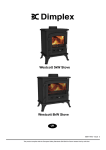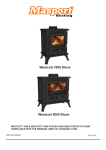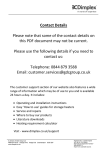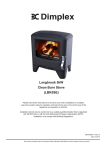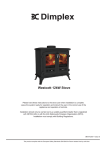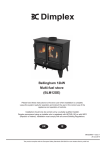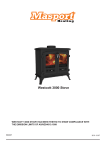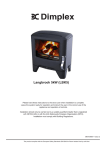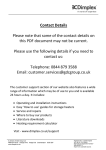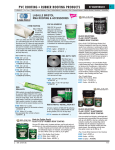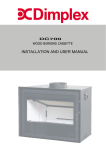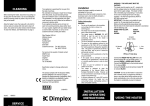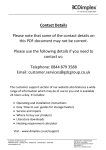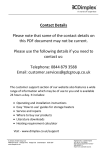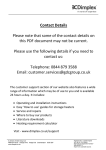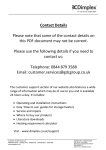Download Dimplex Westcott 8kW Stove Operating instructions
Transcript
Contact Details Please note that some of the contact details on this PDF document may not be current. Please use the following details if you need to contact us: Telephone: 0844 879 3588 Email: [email protected] The customer support section of our website also features a wide range of information which may be of use to you and is available 24 hours a day. It includes: • Operating and installation instructions • Easy ‘How to use’ guides for storage heaters • Service and repairs • Where to buy our products • Literature downloads • Heating requirement calculator Visit ‐ www.dimplex.co.uk/support A division of GDC Group Ltd Millbrook House Grange Drive Hedge End Southampton SO30 2DF www.dimplex.co.uk Registered No: 1313016 England VAT GB 287 1315 50004 EEE Producer Registration Number – WEE/GE0057TS Paper from sustainable sources Westcott 5kW Stove Westcott 8kW Stove Please hand these instructions to the stove user when installation is complete. Leave the system ready for operation and instruct the user in the correct use of the appliance and operation of controls. Installation should only be carried out by a suitably qualified installer that is registered with HETAS (UK) or with the Irish Nationwide Fireplace Organisation (INFO). Installation must comply with Building Regulations. 08/51118/0 - Issue 7 The product complies with the European Safety Standards EN13240 for Room heaters fired by solid fuel. 1 H C D L (Dia) J G A B K F E Table 1 - Dimensions A B C D E F G H J K L Westcott 5kW 580 540 416 208 434 105 55 336 120 425 128 Westcott 8kW 602 554 544 272 564 102 55 309 126 418 154 Note: All Dimensions in mm. Dimensions stated may be subject to a slight ± variation. ( 25.4mm = 1”) Table 2 - Technical Specification Nominal heat output Efficiency CO Emission (@13% O2) Westcott 5kW kW 5.0 8.0 Solid Fuel (Ancit) kW 5.4 8.1 Wood % 79.7 76.6 Solid Fuel (Ancit) % 75.0 70.1 Wood % 0.75 0.58 Solid Fuel (Ancit) % 0.46 0.09 °C 257 399 Wood g/s 3.6 4.7 Solid Fuel (Ancit) g/s 4.8 6.4 hr 1 1 Flue Gas Temp Flue Gas Mass Flow Westcott 8kW Wood Refuel Period Sides mm 600 600 Rear mm 400 480 Flue Outlet Size mm 125 150 Product Weight kg 73 Additional Room Ventilation Required cm² Safe Distance to Combustibles 2 88 See table 4 3 2 A x4 1 4 5 2 1 6 Z Z = At least 150mm or to a suitably heat resistant wall (See table 3) Solid, non-combustible material e.g. masonary or concrete 7 Z Z H T See Table 3 T MIN m m 150 X CONSTRUCTIONAL HEARTH NON COMBUSTIBLE 125mm THICK MINIMUM 300mm X MIN 150mm MIN 125mm Table 3 - Position of Hearth & Appliance from adjacent walls Hearth distance ‘X’ from wall Appliance distance from walls 0mm 8 Min Wall Thickness ‘T’ Min Wall height ‘H’ 0 - 50mm 200mm Height of appliance +300mm or 1200mm from hearth (whichever is greater) 0mm 51 - 150mm 75mm 0 - 150mm 150 - 300mm 75mm +150mm +300mm No Minimum Requirement 9 Seal with fire proof lagging 150 Max Seal gap with fire-proof lagging 150 max 45° Max 150 max 10 11 SEAL CLOSURE PLATE C B D A 12 13 Wescott 5kW & 8kW -1- IMPORTANT: THESE INSTRUCTIONS SHOULD BE READ CAREFULLY AND RETAINED FOR FUTURE REFERENCE Important Safety Advice Please read these instructions carefully before installing or using this appliance. Failure to do so may result in damage to persons and property. Installation of this appliance must be carried out by a suitably qualified competent person in accordance with all Building Regulations, including those referring to Local Authority Bye-Laws, National and European Standards and Codes of Practice. Do not install this appliance on a shared flue. This appliance operates at very high temperatures and retains its heat for a period after use. Do not touch any surfaces while in use. All persons including children and the infirm should be warned of this and not allowed to touch any surfaces while in use. Please use a suitable fireguard to prevent contact when in use. Do not place any photographs, paintings, TV’s or other combustible items near the appliance as exposure to hot surfaces will cause damage. Maintain safe distances from combustibles in all cases in accordance with these instructions – please refer to installation. The operator must use the tools provided. The mitten provided is a tool. Do not fit an extractor fan in the same room as this appliance. Ensure that there is adequate ventilation in the room in accordance with building standards. Do not obstruct any of the air inlets or outlets on the appliance. A flue damper should not be fitted when burning solid fuels other than wood. This appliance is for domestic heating use only in accordance with these operating instructions. Do not make any unauthorised changes to the appliance. Only use recommended fuels. Do not burn petroleum coke fuels, household waste or plastic in this appliance. Burn only fuels with a low moisture content - burning soft or wet fuels such as unseasoned timber or peat will only result in a build up of tar in the stove and the chimney and will cause staining of the glass. Do not use flammable liquids to ignite the fire. Avoid the use of aerosols in the vicinity of the stove when it is in operation. Clean your chimney at least twice a year and clean the flue way weekly to ensure there are no blockages. Do not allow a build up of ash to occur in the ash pan as this will cause the grate to burn out prematurely. Regular maintenance should be carried out by a Competent Engineer. Health and Safety Precautions Handling: Adequate facilities must be available for the unloading and handling of this appliance. This product is heavy and should be handled with care. When handling or servicing this stove care should be taken to avoid the possibility of personal injury. Use protective clothing. Fire Cement/Glue: Some types of fire cement/glue are caustic and should not be allowed to come into contact with the skin. Use suitable protective gloves when handling. In case of contact, wash immediately with plenty of water. Asbestos: This appliance contains no asbestos. If there is a possibility of disturbing asbestos as a result of installation then specialist guidance must be sought prior to installing. Installation Instructions General These instructions give a guide for the installation of the stove but in no way absolves the installer from responsibilities to conform to all relevant standards relating to the installation of solid fuel appliances. We recommend that for UK installations a HETAS registered installer should be used, who will be able to give a Certificate of Compliance that installation complies with Building Regulations. In Ireland a registered installer from the Irish Nationwide Fireplace Organisation should be used. Please note that to the best of our abilities these instructions are correct at time of printing, however we cannot be held responsible for any differences in legislation which may occur in the future. Assembly of the stove To make the product easier for handling on installation, remove the baffle plate, side bricks, back brick and door. Place these in a secure place to avoid damage. These must be refitted after installation. The legs and other fixings are packed in the ashpan for safe keeping in transport. Fix the legs to the underside of the product using the bolts provided (Fig 2). The stove is supplied ready for top flue connection. For Rear flue connection remove the collar and blanking plates and fit in the desired position. The collar can be fitted on the top or the rear of the product. Seal with fire cement to ensure it is air tight (Fig 3). The primary air sealing plate is located on the front of the grate. To locate in position, slacken the screws beneath the grate and pull forward, then close the door fully, open again and tighten the screws (Fig 4). Chimney Before installing, check the chimney is in good condition; dry and free from cracks and obstructions. The diameter of the chimney flue should not be less than 150mm and not more than 230mm. If any of these requirements are not met, the chimney should be lined by a suitable method by a qualified person. The chimney height and the position of the chimney terminal should conform to Building Regulations. If you have any doubts about the suitability if your chimney, consult your local dealer or stockist. The chimney must be swept before connection to the stove and swept every six months thereafter. -2- If there is no existing chimney then either a prefabricated block chimney or a twin walled insulated stainless steel flue to BS4543 can be used. These chimneys must be fitted in accordance with the manufacturers instructions and in compliance with Building Regulations. This product must not be installed on a shared flue. Flue Deposits If the chimney was previously used as an open fire, it is possible that the higher flue gas temperatures generated by the stove may loosen deposits that were previously adhered to the inner surface of the flue pipe which could cause blockage of the flue pipe. We recommend that in this situation a second sweeping of the chimney should be carried out within one month of initial stove use after installation. Flue Draught The chimney should be checked before the stove is installed to ensure that there is adequate flue pull. The draught can be checked initially by using a smoke match close to the flue opening. If the chimney doesn’t pull the smoke it may suggest that the chimney needs further attention. Any remedial work to the chimney flue should be carried out by a suitably Qualified Engineer. A flue draught of minimum 12 Pascal to maximum 25 Pascal is required for satisfactory appliance performance. The flue draught should be checked under fire at high output and if it exceeds the recommended maximum a flue draught stabiliser (or flue damper as it is also known) must be fitted so the rate of burning can be controlled and prevent overfiring. Room Ventilation For safe operation this stove must be provided with combustion air supply in addition to normal room ventilation, in accordance with Building Regulations. Minimum ventilation requirements vary depending on whether the dwelling is considered to be of standard construction or of airtight construction, or if a flue draught stabiliser has been fitted. The required open air vent sizes are as follows: Table 4 - Additional Room Ventilation Required Standard build dwellings {air Westcott 5 permeability >5.0m³ /(h.m²)} Westcott 8 No Flue Stabiliser Not Required 17 cm² With Flue Stabiliser 15 cm² 41 cm² Airtight build dwellings {air Westcott 5 permeability ≤5.0m³ /(h.m²)} Westcott 8 No Flue Stabiliser 28 cm² 44 cm² With Flue Stabiliser 43 cm² 68 cm² An extractor fan must not be used in the same room as this appliance. Floor Protection & Installation Clearances In all instances the stove should be positioned on a noncombustible hearth. The construction of the hearth must conform to Building Regulations, must be firm, non-combustible and capable of supporting the stove. Care should be taken to ensure the stove is level and the hearth is secure. The hearth itself should not be less than 125mm thick, including the thickness of the floor and any decorative top surface (e.g. tiling). Allow an apron of at least 300mm at the front of the stove in case of spills when de-ashing. (Fig 6) shows the minimum distances required from the hearth edge to the sides of the stove. The stove can also be recessed in a suitable sized fireplace. We recommend a permanent free air gap of at least 150mm should be left around the sides where possible and 300mm around the top to obtain maximum heat output and for access to the rear of the stove. Place the product in the desired location on fireproof hearth taking note of installation clearances from adjacent walls (Fig 7). Adjust the screws on the bottom of the feet to ensure the stove is level and steady (see ‘A’ Fig 2). The stove can be screw fixed to the floor when placed in the desired position, using the holes provided in the feet. Table 5 shows the minimum safe distances to combustable materials that must be observed. Any surrounding combustible material should not exceed 80°C. Table 5 Sides Rear Westcott 5kW 600mm 400mm Westcott 8kW 600mm 480mm Flue Pipes The flue pipe used to connect to the stove should be made of cast iron, 316 grade stainless steel or vitreous enamelled steel, nominal thickness 1.2mm. The diameter of the flue pipe should be 125mm (5”) for the Westcott 5kW and 150mm (6”) for the Westcott 8kW models. Connect the flue pipe to the stove making sure that it fits snugly into the base of the flue collar (Fig 5). Seal the collar and flue connection with fire cement or with other suitable high temperature sealant. Add flue sections as required; note that all flue sockets must face upwards. Ensure that the flue pipe end is no closer than 76mm to the side or rear of the chimney walls. It is essential that all connections between the stove and the chimney flue are sealed and made airtight. Avoid using bends greater than 45° to the vertical (Fig 8). All flue pipes should be as close to vertical where possible. For rear flue connection the length of the horizontal run of the flue pipe should not exceed 150mm (Fig 9). Both chimney and flue pipe must be accessible for cleaning and if ALL parts of the chimney cannot be reached, a soot door must be fitted to enable this to be done. Existing Fireplace An existing fireplace opening can be bricked up or sealed with a register plate, 2.5mm sheet steel or concrete. A short length of flue pipe may then be used to connect the stove to the chimney. Ideally the old fireplace should be filled in so that there is a smooth streamlined entry into the flueway. (Fig 9) Typical installation for Inglenook Fireplaces Inglenook fireplaces can have very large bore chimneys (Fig 10). Check with your installer – you may need a stainless steel flexible flue liner for solid fuel fitting. Flue Damper (Not Supplied) When burning wood, a flue damper may be fitted to reduce the draught through the stove if the draught is too high. When the damper is set in the open position the chimney draws at full draught, increasing the volume of air flow through the stove and flue. Shutting the damper restricts the flow, slowing the rate of burning. The damper should be fitted to the stove flue and should be the same size as the flue pipe. As a rule it should be fitted no closer than 700mm from the flue outlet of the appliance. A flue damper should not be fitted when burning solid fuels other than wood. -3- Commissioning Upon completion of installation, the stove and flue system should be tested by a suitably qualified person to make sure it is safe for normal use. A smoke draw test should be completed to check for soundness of joints and seals and also that all smoke and fumes are taken from the appliance up the chimney and emitted safely. First warm the flue with a blowlamp or similar for about 10 minutes. Place a lit smoke pellet on the centre of the grate with the air controls open. Close the door – the smoke should be drawn up the flue and be seen to exit from the flue terminal. Complete the test with all windows and doors shut in the room where the appliance is fitted. If a ceiling fan is present it must be operated on max for the duration of the test. If there are any extraction fans in adjacent rooms these too must be operated on maximum setting during the test with the interconnecting doors open. If any spillage occurs, recheck the suitability of the flue system making sure there is adequate air supply to the room (as per Building Regulations). Light the appliance and slowly increase the temperature to operating levels. Open the main fire door when the appliance reaches normal operating condition and carry out a spillage test using a smoke match or pellet around the door opening. If any spillage occurs, open all windows, allow the fire to go out and recheck the flue system and ventilation. Operating Instructions Warning: The door and operating handles become hot when the stove is in use. For your safety use the glove provided. Initial Firing of Stove We recommend that you have two to three small fires before you operate your stove to maximum heat output. This is to allow the paint to cure and the castings to relax and consolidate location. We recommend this ‘running in’ procedure after long idle periods to preserve the life of the stove. During this you may notice an unpleasant smell. It is not toxic but for your own sake we would suggest that during this period you leave all doors and windows open. Air Controls Primary air is controlled via the sliding vents (A - Fig 11) in the bottom of the door; this provides a conventional air draught to the bed of the fire. (+) indicates more air, (-) indicates less air, (+) and (-) are marked on the primary and secondary air controls. Secondary air is controlled via the sliding vent (B - Fig 11) above the door. It is this ‘Airwash’ that keeps a clean and uninterrupted view of the fire, also aiding in good secondary combustion of fuel and reducing emissions into the chimney and environment. Lighting the Stove Place fire lighters or paper and kindling on the grate. Light the fire at base leaving all air controls open. Allow the fuel to reach a steady glow and build the fire up gradually. Once you have a good fire established across the grate bed, further fuel can be added as required. Running the Stove When your fuel is well alight you can start to restrict the primary air intake. If you are only burning wood the primary air control can be fully closed. If you are burning solid fuel you will require more primary air. Your stove is burning with maximum efficiency when a bright fire is achieved using minimum air inlet. The stove can be banked up for long periods. When burning solid fuel empty the ash pan. Open air controls and let the fire burn brightly for a short period. Refuel and close air controls; the exact setting required will depend on the fuel used and the chimney draw so some practice may be necessary. To revive the fire, open air controls until the fire is burning brightly, de-ash if necessary and refuel. Set air controls as required. The stove is not suitable for overnight burning. Notes on Wood Burning Wood burns best on a bed of ash and it is therefore only necessary to remove surplus ash from the grate occasionally. Burn only dry, well seasoned wood, which should have been cut, split and stacked for 12 months with free air movement around all sides of the stack to enable it to dry out. Burning wet or unseasoned wood will create tar deposits in the stove and chimney and will not produce a satisfactory heat output. When loading wood, make sure that the end grain of the wood in the stove is pointing away from the glass otherwise the moisture and gases coming from the end grain of the wood will dirty the glass. Table 5 - Maximum log lengths Westcott 5kW 300mm (12”) Westcott 8kW 400mm (16”) Notes on Solid Fuel burning (Other than Wood) Always de-ash the grate before refuelling and do not let the ash build up to the underside of the grate bars. Solid fuel produces ash, which if allowed to build up will stifle the air flow through the grate and will eventually cause the fire to die. It is important it is to empty the ash pan after each firing of the stove. Air passing through the firebed cools the grate. Distortion or burning out of the grate bars is nearly always caused by ash being allowed to build up on the underside of the grate. With some solid fuels a residue of burnt fuel or clinker will accumulate on the grate. Allow the fire to go out periodically to remove this. We recommend the majority of approved manufactured smokeless fuels. Note that different types of fuel will give different performances. Use as an incinerator for household waste is not recommended as fumes from plastic, etc will cause pollution to the atmosphere and will cause damage to the stove. Should any difficulties arise over fuel quality or suitability, consult your local supplier or contact the Solid Fuel Advisory Service. Petroleum coke fuels or household waste should not be burned on this appliance. De-Ashing To de-ash the grate insert the notch on the riddle hand tool into the peg on the side of the stove (D - Fig 11), then draw the tool forwards and backwards with a slow positive action (Fig 12). The ash pan should be emptied each time after operating the stove so not to let build up of ash occur. Where possible, it is best to wait until the stove and ash has cooled before removing the ash pan. To remove, open the stove door by lifting the handle upward (C - Fig 11) then using the riddle handle lift the ash pan out of the fire (Fig 13). For efficient burning of your appliance, make sure the grate is clear of burnt debris; e.g. nails, etc. -4- Shut down Periods If shutting down the stove for long periods (e.g. for summer months) make sure that all ash is removed from the stove and that the chimney flue ways and baffle plate are brushed clean. When the stove is cold a vacuum cleaner may be used to remove any residual ash or soot. Close the door and leave all air inlets open fully. This action will ensure air circulation through the appliance and will help to avoid corrosion and condensation within the appliance during this shut down period. Safety Notes for Your Guidance FIRES CAN BE DANGEROUS. Always use a fire guard in the presence of children, the elderly or the infirm. Inform all persons the dangers of high temperatures during operation of the appliance including the stove pipe. Use operating tools provided. DO NOT OVER FIRE. It is possible to fire the stove beyond its design capacity. This could damage the stove, so watch for signs of over firing. If any part of the stove starts to glow red, the stove is in an over fire situation and the controls should be adjusted accordingly to reduce air intake. Never leave the stove unattended for long periods without adjusting the controls to a safe setting. Careful air supply control should be exercised at all times. Warning - Fume Emissions Properly installed and operated, this appliance will not emit fumes. Occasional fumes from de-ashing and refuelling may occur. Persistent fume emission must not be tolerated. If fume emission does persist, then the following immediate action must be taken: 1. Open doors and windows to ventilate the room. 2. Let the fire out, or eject and safely dispose of fuel from the appliance. 3. When the stove has cooled, check for chimney flue blockage and clean if required. 4. Do not attempt to relight the fire until the cause has been identified. If necessary seek professional advice. General Maintenance Baffle Plate This should be removed at least once a month to prevent any build up of soot or ash, which could lead to blocked flue ways and dangerous fume emission. If the baffle plate is removed the chimney/flueway can be swept through the appliance. Stove Body The stove is finished with a heat resistant paint and this can be cleaned with a soft brush. Do not clean while the stove is hot, wait until it has cooled down. The finish can be renovated with a suitable brand of paint. Glass Panels Clean the glass panels when cool with a proprietary glass cleaner. Highly abrasive substances should be avoided as these can scratch the glass and make subsequent cleaning more difficult. Wet logs on heated glass, a badly aimed poker or heavy slamming of the doors could crack the glass panels. The glass will not fracture from heat. Chimney Check your chimney each year before starting to use your stove for the winter. Birds may have nested in the chimney or masonry may have cracked. Both chimney and flue pipe must be swept at least once a year by a Qualified Chimney Sweep. To avoid a build up of soot on the baffle plate (the plate inside the stove above the grate) it must be removed and cleaned periodically. This plate locates the back and side firebricks so note its position before removal. To remove, lift plate and remove one side brick; this will allow the plate to drop and aid removal. To replace, position baffle plate on back and side plate, lift plate and replace remaining brick, making sure it has located in position. This must be done when the stove is cold. Troubleshooting 1. Poor heat output a. Stove too small for room: Seek advice from a Qualified Heating Engineer as to (kW) output required for the room size. As a guideline the volume of the room in cubic feet divided by 500; e.g. room 15’x15’x8’ would require 3.6kW approx. b. Chimney and/or flue pipe restricted, room ventilation restricted: On installation these should have been checked but regular maintenance is necessary as conditions can change; e.g. soot build up, birds nesting, masonry fall, dust build up or furniture blocking vents. c. Poor quality fuel: Only burn dry seasoned timber, soft woods have a lower heat output than hard woods per hour. Solid fuels vary in heat value; check with your coal merchant as to suitability. 2. Dirty Glass Panel a. Generally caused by poor fuel quality, see (1c) b. Use secondary air slide (Airwash) for glass panel c. Fire burning too low, open air vents on stove to create hot fire; this may ‘burn’ glass clean. d. If glass requires cleaning use glass cleaner recommended by your supplier; only use glass cleaner on cold glass. DO NOT USE any abrasives or scrapers as these will scratch glass and increase future tar build up making it harder to clean. 3. Unburnt Fuel in Firebox Insufficient air reaching fuel. Open primary air slide, this will supply combustion air to burn fuel fully (unless it has reached a ‘point of return’). Check if the ash pan is full and empty if required. De-ash with the riddler to make sure the grate is not blocked and check for jammed clinker or nails when the fire is out and the stove has cooled. 4. Smoke and Fumes Entering Room These are very dangerous and must NOT be tolerated. Open window and allow fire to burn out. Seek expert advice immediately. DO NOT USE stove until the problem is solved. 5. Chimney Fire Identified by loud roaring sounds, dense smoke and sparks emitting from chimney. Shut down the air supply by closing air vents, close stove door fully and call fire brigade immediately. Regular chimney maintenance will prevent chimney fires. Seek advice from a Qualified Chimney Sweep. Chimneys must be checked annually and more often when bitumas coal and poor quality smokey fuels are used. -5- After Sales Service As a sign of our commitment to quality, all new Dimplex solid fuel stoves are guaranteed against casting faults and other manufacturing defects for 10 years in the case of non-boiler stoves and 5 years in the case of boiler models, subject to certain conditions and exclusions. The guarantee covers the main body of the stove and external cast parts under normal domestic use - it does not cover use in commercial premises. The guarantee period begins on the date of purchase. The guarantee covers replacement of the parts found to be defective but does not cover labour charges. Conditions and Exclusions: The guarantee does not cover the following items which are deemed to be consumable items under normal use: glass, rope seals, grate, ashpan, cast iron liners, riddling lever, baffle plate, fire bricks and log retainer. It is a condition of the guarantee that the installation complies with relevant Building Regulations and is carried out by a suitably qualified individual (HETAS registered in England and Wales, or equivalent in other countries) with certificate of installation and appropriate commissioning retained by the end-user along with proof of purchase. Whilst the guarantee does not cover any aspect of the flue arrangements for the installation, or the installation work itself, as these are beyond the control of Dimplex as the manufacturer of the stove, it is a condition of the guarantee that the flue be swept by a suitably qualified individual as appropriate but at a minimum interval of once per year. It is expected that the stove would be inspected for developing faults at the time of sweeping to allow any necessary maintenance to be carried out. Damage or defects caused by the following are excluded: over-firing, use of inappropriate fuels such as petroleum coke or household rubbish, flue draft problems, ventilation issues, accident, misuse, fair wear and tear, unauthorised modifications or repairs made using incorrect spares. In normal usage the paint finish of the stove may change colour slightly and in the case of enamel finishes, may develop hairline cracks. As these circumstances are considered normal, they are not covered by the guarantee. Over-firing of an enamelled stove can cause the finish to flake off. Damage caused by over-firing is excluded from the guarantee. It is a condition of the guarantee that only genuine Dimplex spare parts are used. Parts that may need occasional replacement are fire bricks, ashpan, grate and log retainer. NB: sealing rope and rope adhesive are generic stove spares that can be purchased from most stove retailers. Provided the rope seals are replaced like for like and fixed with appropriate stove rope adhesive, this will not invalidate the guarantee. Genuine Dimplex spare parts are available in the UK direct from the manufacturer and can be ordered via www.dimplex.co.uk or by telephone on 0845 600 5111. For Republic of Ireland orders see www.dimpco.ie or Tel: 01 842 8222 Dimplex reserves the right to provide either replacement parts or a replacement stove, at their sole discretion, in order to satisfy claims made under this guarantee. Replacement parts or stoves are covered only for the remainder of the original guarantee period. Dimplex will not be held responsible for any consequential or incidental loss, damage or injury, howsoever caused. The Dimplex stove guarantee does not affect, and is in addition to, your statutory rights. Should you require after sales service or should you need to purchase any spares, please contact the retailer from whom the appliance was purchased. Please do not return a faulty product to us in the first instance as this may result in loss or damage and delay in providing you with a satisfactory service. Please retain your receipt as proof of purchase. WESTCOTT 5kW 6 14 3 2 7 5 15 12 9 8 11 4 16 13 10 1 WESTCOTT 5kW STOVE - SPARE PARTS Item Description Part No 1 Door MF09015 2 Grate Accessory Pack (incl Grate Outer, Grate inner, Con Rod) MF09016 3 Adjustable Grate Plate MF09017 4 Front Bar (log bar) MF09018 5 Air Wash Deflector Plate 3011013 6 Baffle Plate MF09020 7 Grate/Ashpan Operating Tool MF09007 8 Legs Accessory Pack (x2 off) MF09009 9 Primary Air Slide MF09021 10 Air slide knob Accessory Pack (x1 steel, x1 black finish) MF09011 11 Door Handle Accessory Pack (x1 steel, x1 black finish) MF09010 12 Ash Pan MF09022 13 Hinge Pins (x2 off) MF09035 14 Heat Bricks Accessory Pack (x2 side bricks, x1 rear brick) MF09023 15 Door Glass Accessory Pack (includes clips) MF09024 16 Mitten MF09036 WESTCOTT 8kW 6 7 5 15 2 4 13 9 11 3 12 8 16 1 14 WESTCOTT 8kW STOVE - SPARE PARTS Item Description Part No 1 Door MF09025 2 Grate Accessory Pack (incl Grate Outer, Grate inner LH & RH, Connector, Con Rod) MF09026 3 Adjustable Grate Plate MF09027 4 Front Bar (log bar) MF09028 5 Air Wash Deflector Plate 3011014 6 Baffle Plate MF09030 7 Grate/Ashpan Operating Tool MF09007 8 Legs Accessory Pack (x2 off) MF09009 9 Primary Air Slide MF09031 10 Air slide knob Accessory Pack (x1 steel, x1 black finish) MF09011 11 Door Handle Accessory Pack (x1 steel, x1 black finish) MF09010 12 Ash Pan MF09032 13 Door Glass Accessory Pack (includes clips) MF09033 14 Hinge Pins (x2 off) MF09035 15 Heat Bricks Accessory Pack (x2 side bricks, x1 rear brick) MF09034 16 Mitten MF09036 10 DIMPLEX MILLBROOK HOUSE GRANGE DRIVE HEDGE END SOUTHAMPTON SO30 2DF TEL: 0845 600 5111 FAX: 01489 773050 WEBSITE: www.dimplex.co.uk Republic of Ireland Tel: 01 842 8222 [c]A Division of GDC Group Ltd. All rights reserved. Material contained in this publication may not be reproduced in whole or in part, without prior permission in writing of GDC Group Ltd.













